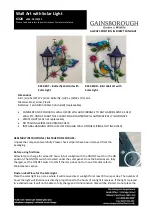
6
solenoid cables avoiding contact with the exhaust system and other vehicle
components that could damage the cable. Also avoid routing the cables near
ignition components or other sources of RF (radio frequency) and EMI
(Electromagnetic interference) noise.
2.3 PowerSafe
Relay
The PowerSafe functions by intercepting one of the two boost control leads
with the included relay. The relay breaks (opens) the circuit when the user
defined conditions are exceeded. The circuit has continuity (closed) in it’s
normal operating state.
1.
Disconnect the battery negative (ground) lead.
2.
Locate your boost controller solenoid and select one of the two
wires. It is not critical which of the two single leads you intercept.
3.
Cut the chosen wire leaving enough wire length on both ends to
connect to the relay wires.
4.
Solder and heat shrink one exposed end of the solenoid wires to the
BLUE
relay wire. Solder and heat shrink the other exposed end of
the solenoid wire to the
YELLOW
relay wire.
It is not critical which
side of the intercepted solenoid wires connects to either of the blue
or yellow relay wires.
5.
Mount the relay in a suitable location away from high temperatures
or near ignition components.
6.
Route the relay cable through the firewall, to the gauge and connect
to the 2 pin connector.
7.
2.4 MAP
sensor
1. The MAP sensor MUST be installed with the hose fitting facing
down.
It is very important that the sensor be isolated from heat
sources, mounted away from all ignition and/or other potential RF
emitting sources, and protected against excessive vibration.
The MAP sensor has two 1/8” holes that can be used to secure the
sensor. Another viable option is to use double-sided mounting tape.



































